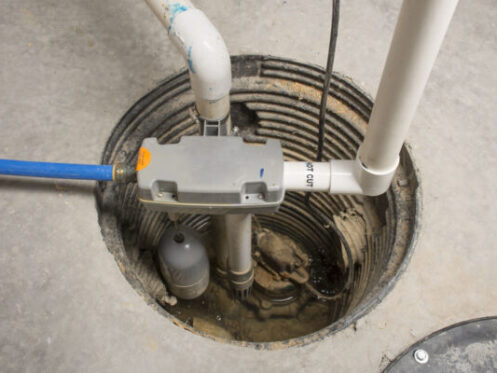Spring is a common season for homes to experience flooding. As the snow turns to rain, it can oversaturate your yard, creating the perfect conditions for sitting water. Sump pumps are vital to keeping below-grade areas dry and structurally sound. Initially, residential homes were built with unfinished crawl spaces that occasional flooding wouldn’t damage. The majority of homes built today have finished basements. This means that it’s even more important to keep the area dry to protect your belongings and important systems.
Common Causes Behind Basement Flooding
While any basement has the chance to flood, there are some more prone than others. Sump pumps can save your basement from permanent damage if you live in an area where groundwater is high. Be sure to regularly examine your yard for any low spots near your foundation. Over time, water can erode the dirt and start pooling around the walls. Extra precautions are a must if your yard slopes toward your home rather than away from it.
Flooding doesn’t always start from the exterior of your home. Other common factors behind basement flooding incidents include hot water tank and water supply line issues. When floods come from pipes in the walls, you may find clues prior to a major event. Dark stains and wet spots are signs that your pipes may create a flooding emergency in the future. Also, ensure that your pipes are adequately insulated if you use them year-round. Freezing events in the winter can put harmful strain on your pipes, leading to fissures and cracks.
How Sump Pump Systems Work
Two main types of sump pumps are used in residential homes to safely drain water away. A float-activated system has a floater ball that lifts as the water level rises. This moves the activator arm up, which then starts the motor. A pressure-activated pump can read when the water puts pressure on the system’s sensor, activating the draining process.
There are also submersible and pedestal sump pumps that dictate where the pump itself is located. Submersible pumps are waterproof and sit below the water line at the base of the pit. A protective screen covers the bottom, so it can suck up water without catching any debris. Pedestal pumps have the system resting above the water on top of a long inlet pipe. These systems are often louder but don’t cost as much as submersible options.
A sump pump usually sits in a constructed pit in the lowest area of your basement. There’s often gravel at the bottom of the basin where the water collects. The pump itself is connected to various valves that sense the water level. When the system activates, it pumps water out through the discharge line to a designated drainage area. Typical sump pumps require electricity and can be plugged into a standard home outlet with a ground fault circuit interrupter. Some sump pumps come with a battery backup that will continue to keep your basement dry for a few hours to a few days during a power outage.
Your pump should be set up to transport the water to a nearby storm drain, creek, or dry well. It must lead to a spot at least 10 to 20 feet away from your foundation to stop any water from seeping back inside. Some cities and states have specific code requirements for sump pumps. Your local professional will know those codes and be able to keep you in compliance.
Benefits of Sump Pumps
A sump pump is a small investment into the safety of your property and belongings. When moisture finds its way into your basement, the pump will force it out and away from your home. Keeping the area dry protects your carpets and prevents your paint and wall coverings from peeling. These systems reduce the chances of mold, mildew, and other fungus growth that can harm your indoor air quality. A drier environment also helps to discourage termites and other pest infestations.
Along with keeping your foundation intact, a sump pump allows you to rest easy knowing your basement appliances are dry and functioning. Depending on what you store in your basement, a sump pump may keep your HVAC system, washing machine, or deep freezer safe. Installing a sump pump may even be a requirement to stay qualified for your homeowner’s insurance coverage.
Expert Sarasota Residential Plumbing Team
Next Level Plumbing is a premier, customer-focused plumbing company serving Sarasota and the surrounding areas. Our well-trained plumbers work hard to exceed all your comfort expectations. Regardless of your service needs or the size of your assignment, you can always trust us to be professional, respectful, and efficient. We can expertly repair your pipes, drains, slab, and sewer lines. Our team is also ready to detect leaks, perform camera inspections, and complete repiping projects. Don’t forget to keep us in mind if you need help with a fixture or appliance installation. Call us at Next Level Plumbing today to learn more about sump pumps in Sarasota.

